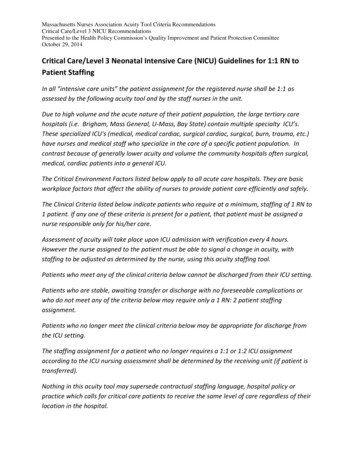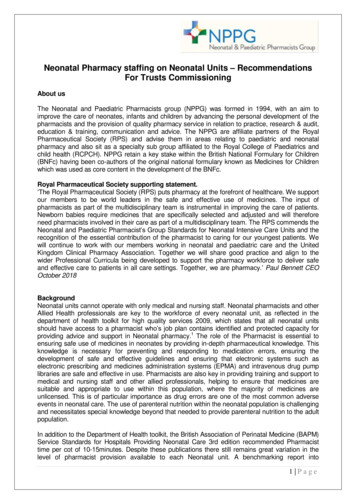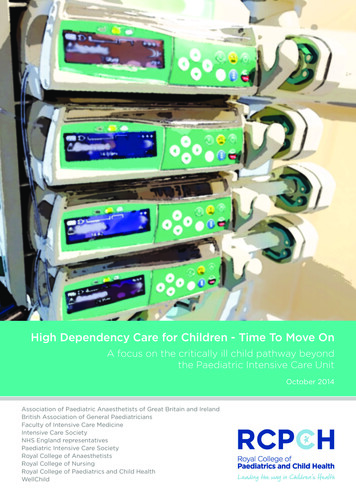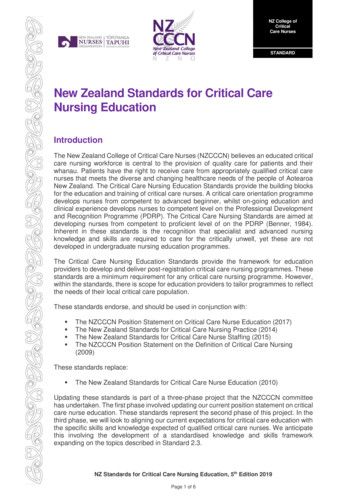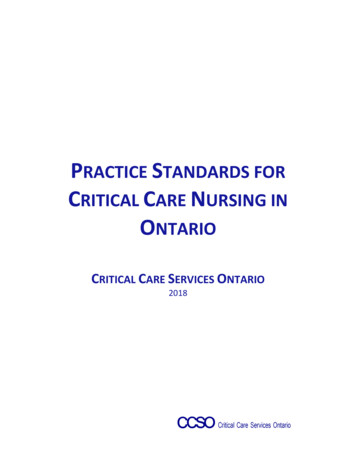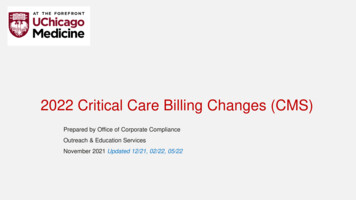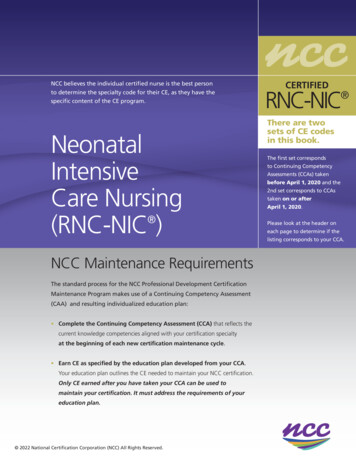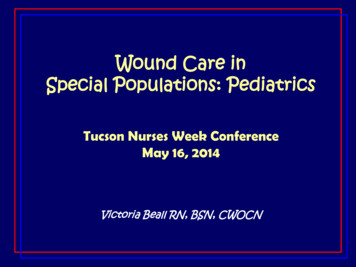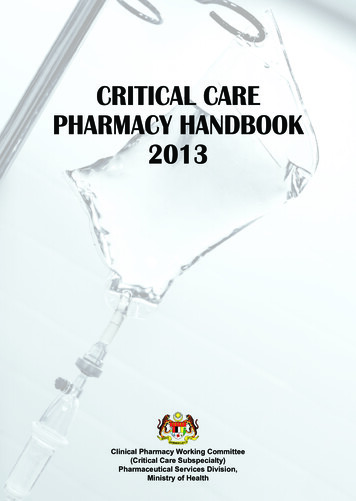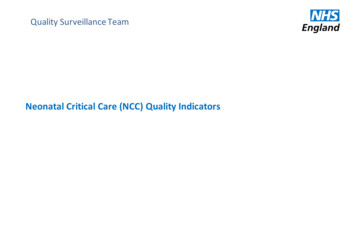
Transcription
Quality Surveillance TeamNeonatal Critical Care (NCC) Quality Indicators
Neonatal Critical Care Quality IndicatorsIntroductionThese neonatal critical care quality indicators have been developed using the following primary source documents: The specialist commissioners’ service specification for Neonatal Critical Care (Intensive Care, HDU and Special Care), E08/S/a. The British Association of Perinatal Medicine (BAPM), Service Standards for Hospitals Providing Neonatal Care (3rd edition), 2010. The BAPM Categories of Care 2011. The National Neonatal Audit Programme 2015 Annual Report on 2014 data. The NHSE special commissioners’ Neonatal Quality Dashboard. Toolkit for High Quality Neonatal Services. NHS & Department of Health, October 2009. NICE Neonatal Specialist Care Quality Standard QS4 2010.The definitions of the different categories of neonatal care and types of neonatal unit (NNU), are as in the source documents below, and can be summarised briefly asfollows:Neonatal Care Categories.1. Normal Care is that deliverable by a mother without professional help. This does not usually feature in documents specifying care categories but is stated here todefine a baseline.2. Transitional Care needs the mother to be resident within a healthcare setting, possibly providing some care herself but receiving support from a midwife or otherhealthcare professional (HCP). Transitional care may be delivered on a standard postnatal ward or a dedicated transitional ca re ward.3. Special care is care which needs the input of specialist neonatal services, on some type of NNU but does not need High Dependency Care or Intensive Care. Specialcare is defined further by a list of specific procedures4. High Dependency Care is care on a NNU which needs a greater degree of input than Special Care, but where the ratio of nurse to patient is less than for IntensiveCare. It is further defined by a list of specific procedures5. Intensive Care is care on a NNU which needs a greater degree of input than High dependency Care. It is further defined by a list of specific proceduresTypes of NNU.There are three types of NNU—Special Care Units (SCUs), Local Neonatal Units (LNUs) and Neonatal Intensive Care Units (NICUs).Special care units (SCUs) provide special care for their own local population. Depending on arrangements within their neonatal network, they may also provide some highdependency services. In addition, SCUs provide a stabilisation facility for babies who need to be transferred to a neonatal intensive care unit. (NICU) or local neonatal unit(LNU) for intensive or high dependency care and they also receive transfers from other network units for continuing special care.June 172neonatal critical care services
Local neonatal units (LNUs) provide neonatal care for their own catchment population, except for the sickest babies. They provide all categories of neonatal care, but theytransfer babies who require complex or longer-term intensive care to a NICU, as they are not staffed to provide longer-term intensive care. The majority of babies over 27weeks of gestation will usually receive their full care, including short periods of intensive care, within their LNU. Some networks have agreed variations on this policy, due tolocal requirements. Some LNUs provide high dependency care and short periods of intensive care for their network population. LNUs may receive transfers from otherneonatal services in the network, if these fall within their agreed work pattern.Neonatal intensive care units (NICUs) are sited alongside specialist obstetric and foeto-maternal medicine services, and provide the whole range of medical neonatal carefor their local population, along with additional care for babies and their families referred from the neonatal network. Many NICUs in England are co-located with neonatalsurgery services and other specialised services in other networks.NetworkingNCC services are now required to be provided as part of NHS Operational Delivery Networks (ODNs). The term ‘network’ is used to mean the sum total of all the NCC services in the area, linked together as a network, intended to fulfill the principles laid down byNHSE for an Operational Delivery Network and designated as such by the relevant commissioners. The term ‘network governance body’ is used for the governance structure within an agreed, designated Operational Delivery Network which deals with thenetworking activities of the NCC services, whether that is a subspecialist part of a wider system which also deals with other services or one dedicated solely to NCC.All relevant provider services in the network should be represented (either directly or via agreed delegation arrangements) on, and come under the agreements of, thesame network governance body, so that conversely the extent of the ‘network’ is defined by those services which share the same single, named, network governance body.This implies that mothers and babies will normally be referred within the host network according to the agreed pathways, however some specialist neonatal surgery andcardiac may routinely go to other services.There is an overall principle to provide care as close to home as possible, but compatible with the category of care and type of unit needed by the neonate. However, sincecurrent neonatal ODN networks cover more than one (some, several) NICU/referring units complexes, this principle may not be optimally achieved merely by aiming tokeep the neonate within its ‘host network’ or ‘network of first referral’. The agreed pathways within a network may be able to go further than this towards achieving thisprinciple.These indicators should be applied to the NNU. Responsibility for the first of these indicators (E08-17-001) lies with the chief executive, (or their authorised deputy),responsibility for the subsequent indicators lies with the lead clinician of the NNU.June 173neonatal critical care services
IndicatorsStructure and ProcessNumberIndicatorData SourceE08-17-001The NNU is part of the ODN network governance groupSelf-declarationDescriptorE08-17-002NotesThe NNU should be party to an agreement with the relevant commissionersthat it is a component of a named neonatal ODN network. The agreementshould specify: the neonatal services within the network the NNU representation on the network governance body. The terms of reference relating to the NNU and the networkgovernance body.Operational policyThe NNU is represented at network governance group meetingsSelf-declarationDescriptorE08-17-003June 17Evidence requiredNotesEvidence requiredThe NNU should send clinical representation to all the governance groupmeetings.Annual reportincluding meetingattendanceThere are named personnel for lead rolesSelf-declarationDescriptorNotesEvidence requiredThe NNU should have single named personnel for the following unitleadership roles(2) lead nurse lead consultant neonatologist/paediatricianOne person may occupy more than one role asappropriate within the boundaries of theirprofessional discipline.Operational policy4neonatal critical care services
lead for non-medical staff traininglead for discharge planninglead for breast feedinglead for family centred carelead for bereavement supportEach of these should have an agreed list of responsibilities and time specifiedin their timetable for the role.E08-17-004There is a multidisciplinary team of specialist AHPsSelf-declarationDescriptorNotesEvidence requiredThe NNU should have the following specialist allied health professionals withtime specified for neonatal care neonatal / paediatric dietitians neonatal occupational therapists neonatal physiotherapists neonatal pharmacist speech and language therapist person providing psycho-social supportThe time specified may form part of theindividual’s wider role.Operational policyThe service may be network-wideEach of the above should meet the staffing requirements specified in theToolkit for high quality neonatal services (DH 2009)E08-17-005The NNU meets the requirements for medical staffingSelf-declarationDescriptorNotesThe NNU medical establishment meets the requirements as specified in theToolkit for high quality neonatal services (DH 2009)June 175Evidence requiredOperational policyMedical rotas shouldbe available for areview visitneonatal critical care services
E08-17-006E08-17-007There is 24/7 consultant neonatologist adviceSelf-declarationDescriptorNotesEvidence requiredThe NICU provides 24/7 consultant neonatologist advice and support servicefor health care professionals including: paediatricians delivering neonatal care at LNU and SCU within thenetworkFor networks with more than one neonatalintensive care unit, this may be shared betweenthe unitsOperational policymedical rotas shouldbe available for a peerreview visitThe NNU meets the requirement for nurse vidence requiredNurse staffing levels meet the requirements specified in the Toolkit forNeonatal Services (DH2009),and in particular meet the following staff to babyratios: 1:1 for babies requiring intensive care 1:2 for babies requiring high dependency care 1:4 for babies requiring special careOperational policyThere is training for registered and non-registered nursing staffSelf-declarationDescriptorNotesAt least 70% (special care) and 80% (high dependency and intensive care) ofthe nursing workforce establishment should hold a current nursing andMidwifery Council (NMC) registration.At least 70% of the registered nursing and midwifery workforce establishmenthold an accredited post-registration qualification in specialised neonatal care(qualified in specialty (QIS))Evidence requiredAnnual reportincluding details oftraining. Details ofcompetencies shouldbe available for areview visitNon-registered staff providing direct nursing care should undertakecompetency based training appropriate to their role and responsibilities.There should be a record of training for each member of staff.June 176neonatal critical care services
E08-17-009There are integrated community support/ outreach servicesSelf-declarationDescriptorNotesEvidence requiredThere should be a neonatal community support / outreach team to provideadvice and support for families caring for their babies at home.The team may either be an integrated hospital/community team or a team ofcommunity professionals.Operational policyThe NNU should: ensure the members of the team have the specialist training required provide information on the babies care plan ahead of discharge arrange for parents to meet the community team prior to dischargeE08-17-010E08-17-011There are network agreed pathways in placeSelf-declarationDescriptorNotesEvidence requiredThere are network agreed neonatal pathways in place which are integratedwith other maternal and new-born pathways. The pathways should include: in-utero and postnatal transfers for neonatal special care, highdependency care and intensive care neonatal surgical care neonatal specialist cardiac care ophthalmology discharge and follow up as specified in the services specification palliative carePatient pathways specify how the differenthospitals and groups of professionals shouldinteract at defined stages of the patient journey,for diagnosis, assessment, management orfollow up. Where relevant, pathways shouldtake into account nationally or internationallyagreed guidance and standardsOperational policyincluding pathwaysThere are clinical guidelines for the care of babies on the unitSelf-declarationDescriptorNotesEvidence requiredThere should be clinical guidelines in place for the care of babies on the unit.Clinical guidelines cover guidelines, protocols,‘SOPs’ which describe how to manage a patientin a given clinical situation or specified point onOperational policyincluding guidelinesGuidelines should be consistent with current network and national guidelinesJune 177neonatal critical care services
where relevant.the pathway.Some guidelines may be common to all threetypes of unit; others will be specific to only oneor two depending on their levels of care.Ref: NICE guidelines for Jaundice, Early onsetsepsis, hypoglycaemiaE08-17-012There is a clinical governance process in placeSelf-declarationDescriptorNotesThere should be a multi-disciplinary clinical governance process in place tomonitor the quality of care including: joint perinatal mortality review with maternity services joint neonatal mortality review process with other services of sharedcases joint perinatal morbidity review with maternity services including:term admissions, babies admitted below gestational threshold,babies admitted with HIE review of clinical incidents and dissemination of actions / learningpoints within Trust and the ODN outcomes of extreme preterm babies at 2 years of ageEvidence requiredOperational policyParent/ Carer ExperienceE08-17-201Parent/Carer feedback is reflected in service developmentSelf-declarationDescriptorNotesThe NNU should have undertaken an exercise during the previous two yearsto obtain feedback on parents/carers’ experience of the services offered.Evidence requiredAnnual reportincluding actionsagreedThe exercise and actions taken as a result should have been presented to,June 178neonatal critical care services
agreed and discussed with the unit, relevant trust governance group, and thenetwork governance body, and shared with parents/carersE08-17-202There is information for parents and carersSelf-declarationDescriptorNotesEvidence requiredThe NNU should have written information for patients covering at least thefollowing: the service offered local unit information includingo Accommodationo Parkingo Public transporto Food for families financial help support services information about the baby’s care within the network setting breastfeeding/expressing hand-washing and infection control how parents can be involved in the care of their babyIt is recommended that the information isavailable in languages and formatsunderstandable by patients including local ethnicminorities and people with disabilities. This maynecessitate the provision of visual, audio anddigital material.Operational policyexamples ofinformation should beavailable for a reviewvisitThe NNU written information should be provided within 24 hours ofadmission to the unit.08-17-203There are facilities for familiesSelf-declarationDescriptorNotesThere are dedicated facilities for families of neonates which should include: overnight accommodation for parents (1) arrangements for secure and readily accessible storage ofparents’ personal items; non-secure storage for personal items (e.g. babyclothes); private breast feeding/ expressing facilities; a parent sitting room;June 179Evidence required(1) As specified in the Toolkit for high qualityneonatal services (DH 2009)Operational policyneonatal critical care services
E08-17-204a kitchen with hot drink and snack-making facilities,a toilet and washing area;a changing area for other young children;a play area for siblings of infants receiving care;access to a telephone and internet connection within thehospital;a room set aside and furnished appropriately for counsellingfree parking facilitiesThe NNU undertakes an audit of family centred careSelf-declarationDescriptorNotesEvidence requiredThe NNU should undertake an audit of family centred care using the BlissBaby Charter Audit Tool, develop a plan and implement actions forimprovement.Annual reportincluding action planClinical Outcomes / Quantitative IndicatorsIntroductionThe data for the following quantitative indicators will be obtained directly from the relevant data source.Categories:This section’s key feature is that the indicators are quantitative, rather than qualitative , measures of processes or proxies for outcomes. A few can beconsidered as quantitative structural parameters, which are of contextual interest.Interpretation issues If a parameter is outside the control of the service under review, although it may be very influential on its outcomes, it is a contextual parameter whichcan’t be legitimately used in the direct judgement of the quality of care of the service but may be of great interest. Some parameters are partly underthe service’s control and partly outside it, making for difficult interpretation.NumberIndicatorData SourceDescriptorE08-17-101Retinopathy ScreeningSSQDUnit, ClevermedPercentage of babies born at less than 32 weeks ofgestation and/or with a birth weight less than 1501 g whoreceive specialist neonatal care and undergo retinopathyscreening in line with national guidelines on timing.June 17Notes10neonatal critical care services
E08-17-102Line-associated bloodstreaminfectionSSQDUnit, ClevermedProportion of babies with positive blood culture after 72h ofage standardised to a rate per 1000 catheter days.E08-17-103Admission HypothermiaSSQDUnit, ClevermedProportion of new-born babies born at less than 34 weeksof gestation admitted for neonatal care from delivery suitewho have an admission temperature of less than 36C.E08-17-104Birth Place of ExtremelyPremature Network BabiesSSQDUnit/network,ClevermedProportion of babies born at less than 27 0 weeks ofgestation (or multiple pregnancies 28weeks) who are bornin a hospital with a NICU, in the Network.E08-17-105Mortality ratesMBRRACE UKThe data in the annual MBRRACE UK Perinatal MortalitySurveillance Report is shown for the relevant commissioningand service delivery organisations,with the mortality analysis based on the mother’s addressat the time the birth occurred and theplace of birth, respectively. There are separate maps forstillbirths, neonatal deaths, and extendedperinatal deaths.E08-17-106Neonatal Network Report Care Location ExceptionSummaryBadgernet(network reports)List of babies who breached a care location exception, byidentified exception criteria, within selected date range.E08-17-107Nurse staffing / ActivityBadgernet(network reports)Shows the percentage of shifts staffed to DH Toolkitstandards (based on number of staff required against theacuity of patients on the NNU at the time) and thepercentage of shifts with a team leader. Also a nationalaverage comparison against units of a similar level of unit,within a selected date rangeE08-17-108NNAP Audit 2017NNAP(2014,2015,2016)Shows the performance of each NNU against 17 NNAP auditquestions in 2016 compared to set audit standards (wherethese exist), averages by level of NNU and national averagetoo. Outlier analysis is also provided for a small number ofJune 1711The 2017 Annual Report (due to bepublished 22nd June 2017) is basedon the births in 2015 calendar yearneonatal critical care services
the audit questions (3 in 2015)June 1712neonatal critical care services
AppendixPatient flows between NNUsJune 1713neonatal critical care services
These neonatal critical care quality indicators have been developed using the following primary source documents: . This implies that mothers and babies will normally be referred within the host network according to the agreed pathways, . E08-17-008 There is training for registered and non-registered nursing staff Self-declaration .
